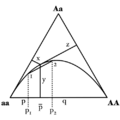Hardy–Weinberg law facts for kids
The Hardy–Weinberg law is a very important rule in population genetics. It helps us understand how genes are passed down in a group of living things. Two smart people, an English mathematician named G.H. Hardy and a German doctor named Wilhelm Weinberg, came up with this idea independently. You might also hear it called the Hardy–Weinberg equilibrium or Hardy–Weinberg principle.
This law is a key part of studying how populations change over time. It says that the amounts of different alleles (different versions of a gene) in a population will stay the same from one generation to the next. This is true unless something specific disturbs them. Think of it like a balanced scale. If nothing pushes or pulls it, it stays level.
Contents
What Can Change Gene Frequencies?
The Hardy–Weinberg law describes a perfect situation where gene amounts don't change. But in the real world, things often do change! These changes are called "perturbations" or disturbances. Here are the main things that can make gene frequencies shift:
Gene Mutations
A mutation is a random change in the DNA of a gene. It's like a typo in a genetic instruction. New mutations can introduce new alleles or change existing ones. This can slowly alter the balance of alleles in a population.
Natural Selection
Natural selection happens when certain traits help living things survive and reproduce better. For example, if a specific allele makes an animal faster, that animal might escape predators more often. It will then pass on that "faster" allele to more offspring. Over time, this allele will become more common in the population.
Small Population Size
In very small populations, random events can have a big impact.
- Genetic drift: This is when allele frequencies change by chance, not because of natural selection. Imagine a small group of people. If a few people with a rare allele happen to have many children, that allele might become more common just by luck.
- Inbreeding: This happens when closely related individuals mate. It can increase the chances of offspring having two copies of a rare or harmful allele.
Non-Random Mating
The Hardy–Weinberg law assumes that individuals mate randomly. This means any individual has an equal chance of mating with any other individual. But sometimes, mating isn't random. For example, individuals might choose mates based on certain traits. This can change how alleles are combined in the next generation.
Migration
Migration is when individuals move into or out of a population.
- If new individuals come in (immigration), they can bring new alleles or change the amounts of existing ones.
- If individuals leave (emigration), they take their alleles with them. Both can shift the overall gene balance.
Predicting Gene Combinations
The Hardy–Weinberg law also helps us predict how different gene combinations (called genotypes) will show up in a population.
Let's say there are two versions of a gene, A and a.
- If the amount of allele A in the population is 'p'.
- And the amount of allele a is 'q'.
Then, the law predicts the following:
- The chance of an individual having two A alleles (genotype AA) is p2.
- The chance of an individual having two a alleles (genotype aa) is q2.
- The chance of an individual having one A and one a allele (genotype Aa) is 2pq.
This means we can use simple math to understand how traits are passed down in a large group of living things. It helps scientists test ideas about how different traits are inherited.
Images for kids
See also
 In Spanish: Ley de Hardy-Weinberg para niños
In Spanish: Ley de Hardy-Weinberg para niños


